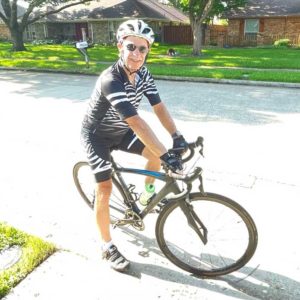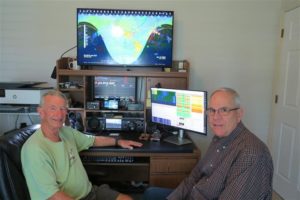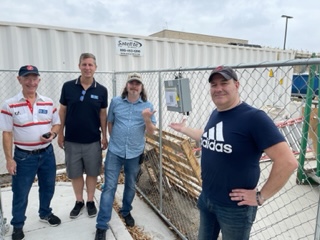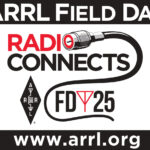by Brian Murphy WB8QZM

On a typical hot August day in 2020, I found my path back to ham radio. I was used to cycling 20 miles a day but for the last two, had experienced unusual shortness of breath. Upon the advice of my doctor daughter, I went to the Plano Heart Hospital ER. When I walked in the door and explained my symptoms, things started happening fast.
Tests and an X-ray confirmed I had a large blood clot in my lungs. A PE, I was told – something many people don’t survive. I was lucky. However, the doctor said the X-ray also showed a mass on my pancreas. I spent that night in the ICU fearing I had pancreatic cancer. The next morning, another doctor came into my room with better news: I had a Pancreatic Neuroendocrine Tumor (NET), a different and less deadly form of disease, yet technically still cancer. I since have learned much about NET, which is treated as a chronic disease, much like diabetes.
What’s this have to do with ham radio? I could have moped around feeling sorry for myself, but instead I got back on my bike and then began doing all those home repairs, etc. I had been ignoring. After completing most, including cleaning out and reorganizing my garage, I began thinking about what else I might do to stay active. My wife and I used to travel quite a bit, but our combined health issues rule that out. Something inspired me to get back into ham radio – even though I had just a year prior sold all my old ham gear after cleaning out the attic.
Allow me to digress. I got my novice ticket in 1962 when I was a high school sophomore and soon upgraded it to a general (K8ZSV). I lived on a farm so had lots of room for antennas and had my ham shack upstairs in our granary. I started with a used National NC-300 and a Viking Challenger (kit) and saved up to buy and build a Heath SB-102 transceiver.
During my college years at Ohio University in southeast Ohio, I worked full-time during summers and vacations so didn’t have much time for ham radio. After graduating from OU, I worked for a year in Dayton and then enlisted in the USAF where I earned my wings and eventually became a C-130 transport pilot.
With all that happening, I accidentally let my ham license expire but took and passed the advanced exam, including the required code, around 1971 (WB4ZQS). I had my SB-102 and built an SB-200 amp while living in and flying out of Fayetteville, NC. In 1973 I left active Air Force duty and luckily got a job back in Dayton, where I and my family then lived for five years. In 1978 a company/career change took us to Michigan, then Minnesota, and finally in 1981 to Plano, where my ham gear stayed packed away in the attic until I sold it.
In October 2021 I modestly re-entered ham radio, thinking QRP was the answer. I bought a Xiegu G90 transceiver and then discovered Plano has a toy store named Ham Radio Outlet (HRO) where I bought a power supply, multiband end-fed antenna, coax, etc. to get on the air. However, it wasn’t long before I found myself dissatisfied with my poor reception.

I soon found myself back at HRO, leaving with a new Yaesu FT-DX10 transceiver. Much better reception, and (with the increased power output) much better results. I re-discovered my love of DX, mostly on CW. Simultaneously I was “discovered” by Dick Burroughs (N5KIP), an amazing “Elmer” who had spotted my name among new members of the Straight Key Century Club (SKCC). He saw we both lived in Plano and shot me an email introducing himself. Shortly thereafter, I stopped at his QTH during one of my bike rides and he gave me a tour of his ham shack and gear.
He had much to show me, and I had much to learn after being inactive for 40-plus years. It was like drinking from a fire hose. I was there for a couple of hours as Dick patiently explained and demonstrated various station components and websites. Most of it didn’t exist back when I was last active in 1978. There were new bands, new brands, new rules, new technologies, and hundreds of new activities and awards for me to absorb.
His teaching and assistance continue to this day. I soon set a self-goal of upgrading to Extra Class and began seriously studying for the exam, with his encouragement. That study helped me fill in the gaps to build upon my experience and prepare for the exam and to operate once I passed. A Google search for licensing locations led me to the Richardson Wireless Klub and when I felt ready, I applied for the on-line exam.
The RWK volunteer examiners eased my anxiety by guiding me through the testing process, despite it living up to my last name (Murphy as in Murphy’s Law) when my ailing PC decided to reboot itself when I was about three-fourths the way through the questions. Once we reconnected and I was able to resume, I finished and learned I had passed and was well prepared. The more I interact with RWK members, the more I enjoy their company and activities.

With Dick’s teaching and assistance, I have gotten into Parks on the Air (POTA), SKCC activities, tracking and fixing interference issues with my shack, installing a 6- through 40-meter vertical, earning two Worked all States awards, and something called FT-8, which I quickly attacked with a vengeance. I’m one country shy of earning my DXCC award. Dick also invited me to share in weekly schedules with his friend in Louisiana, where Dick was previously highly active in their local ham club. Dick also enjoys studying radio propagation, which I’ve learned to use while DX chasing.
I’ve been participating in various RWK activities, including the in-person monthly meetings, the weekly Wednesday “hungry hams” lunches at Sonny Bryan’s, the monthly Saturday morning breakfasts, and the Friday Zoom lunches. At my first Sonny Bryan’s lunch meeting, members introduced me to foxhunting, which I find highly interesting and fun. I learn so much just listening to members’ conversations at various functions, in addition to what Dick has taught me.
What’s ahead? I don’t know for certain. NET cancer is rare and no two people who have it share the same symptoms or outcomes. Ironically, Dick is a retired oncologist. I recently realized that of all my treatments, none compares with what Dick has provided me: helping me pursue our ham radio hobby. I really appreciate what he and the RWK members have done to help me continue to live a positive and active life.
73, Brian WB8QZM



